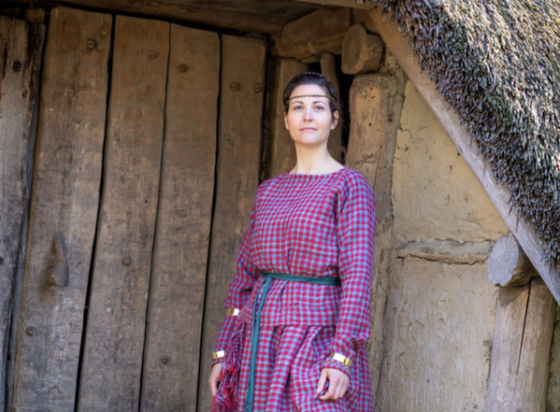Colourful prehistoric ‘Chanel dress’ goes on show


The reconstruction of a dress worn in the Netherlands nearly 3000 years ago has gone on display in Oss, and shows that, contrary to popular opinion, woman from that time liked cheerful colours.
Close investigation of the remnants of the dress, which date from 800 BC and were found in a prehistoric burial ground near Uden in 2011, show the original garment had been an intense red and blue.
The discovery was special in more ways then one, archaeologist Richard Jansen told current afairs programme Nieuwsuur. ‘We would have expected the remains to have been cremated but what we found was the imprint of a skeleton, very likely a woman.’ Apart from the cloth, archaeologists found three bronze bracelets, as well as a nail cleaning utensil and a pair of tweezers.
‘She was definitely a lady of high status,’ archaeologist Sasja van der Vaart said. ‘We have never seen this combination of artifacts before.’
The textile remnants make the find a very special one because they rarely survive in the ground. ‘The reason we have them now is because the bits were wrapped around the bracelets. The bronze rusts and that has had preserved the cloth. The exciting thing is that we can see the pattern of the cloth, in red and blue. The threads have been woven in a check, a very familiar pattern to us,’ Van der Vaart said.
The dress was reconstructed by Yvonne Lammers, who is head of the prehistoric village museum in Eindhoven. ‘We know a lot about Iron Age man. They were farmers with fields and animals and they were completely self-sufficient. We know they used wool and linens and could spin and weave. But this is no ordinary frock. You should think of it as a Chanel dress, that’s how much work was involved in making it.’
Lammers said it was nice to see a change to the usually drab image of prehistoric people. ‘Many people think they were dressed in brown shifts stirring brown stuff in brown pots. Now we can show them that there were people who cared about how they looked even then.’
The dress and the other artifacts can be seen until January 16 at the Jan Cunen museum in Oss.
Thank you for donating to DutchNews.nl.
We could not provide the Dutch News service, and keep it free of charge, without the generous support of our readers. Your donations allow us to report on issues you tell us matter, and provide you with a summary of the most important Dutch news each day.
Make a donation